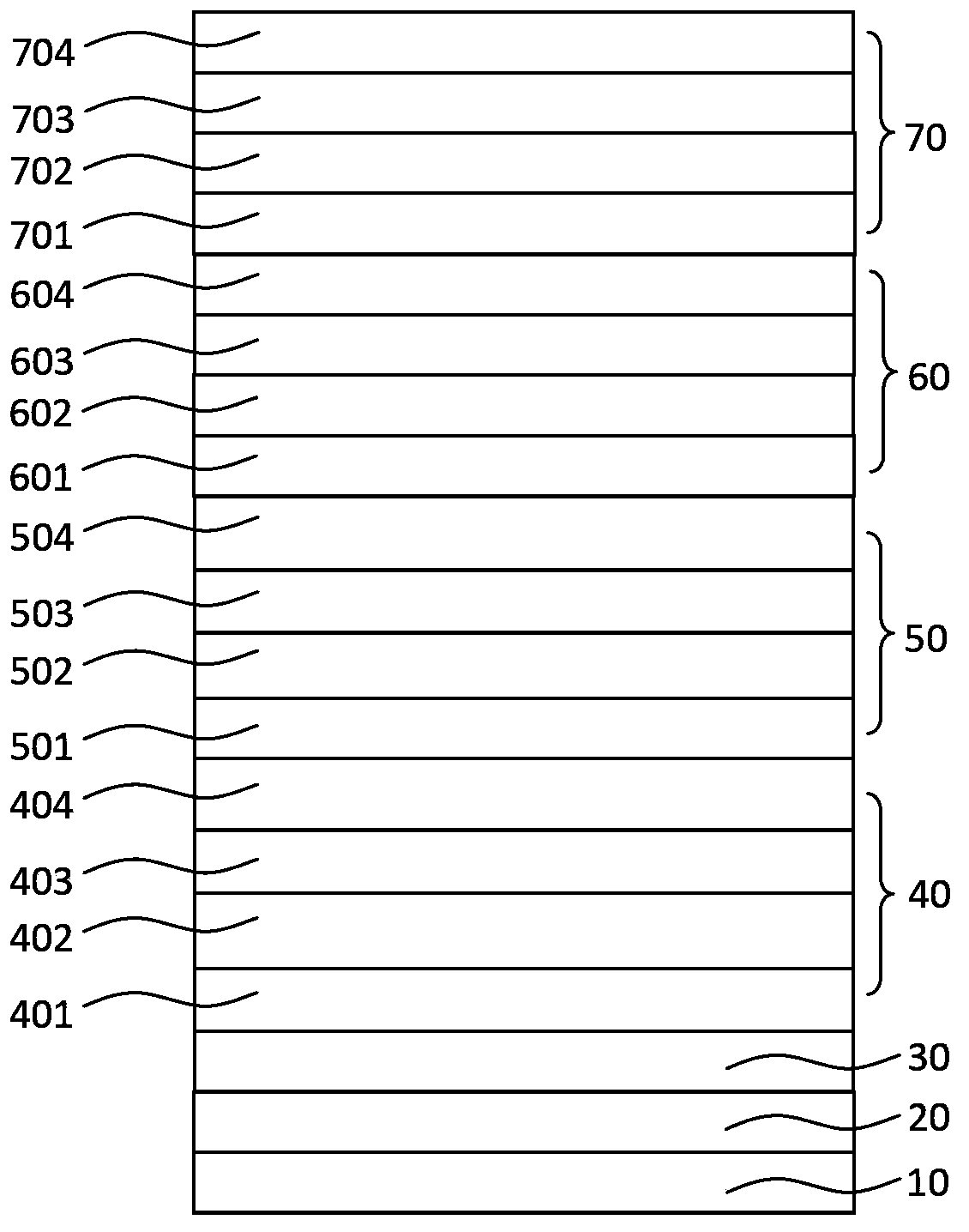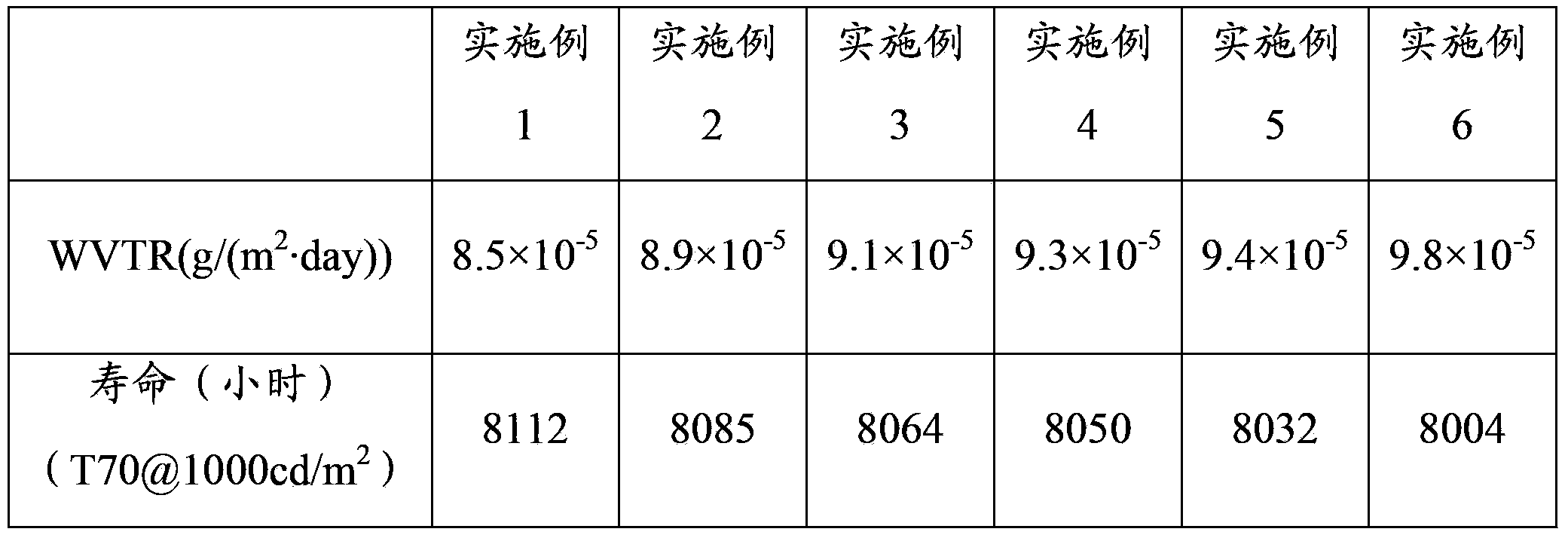Organic light-emitting diode and preparation method thereof
An electroluminescent device, electroluminescent technology, applied in the direction of electric solid device, semiconductor/solid state device manufacturing, electrical components, etc., can solve the problems of heavy weight, short service life, poor mechanical strength, etc., and achieve the effect of good sealing
- Summary
- Abstract
- Description
- Claims
- Application Information
AI Technical Summary
Problems solved by technology
Method used
Image
Examples
Embodiment 1
[0117] An organic electroluminescent device is prepared through the following steps:
[0118] (1) Provide a clean anode conductive substrate:
[0119] Clean the ITO glass substrate with acetone, ethanol, deionized water, and ethanol in an ultrasonic cleaner in sequence, wash and wash for 5 minutes in one item, then blow dry with nitrogen, and dry in an oven for later use; surface activation of the cleaned ITO glass processing; ITO thickness is 100nm;
[0120] (2) Vacuum evaporation of the luminescent functional layer on the ITO glass substrate:
[0121] Specifically, the light emitting functional layer includes a hole injection layer, a hole transport layer, a light emitting layer, an electron transport layer and an electron injection layer;
[0122] Preparation of the hole injection layer: the MoO 3 The mixture obtained by mixing with NPB according to the mass ratio of 3:7 is used as the material of the hole injection layer, the thickness is 10nm, and the vacuum degree is ...
Embodiment 2
[0137] An organic electroluminescent device is prepared through the following steps:
[0138] (1), (2), (3) are the same as embodiment 1;
[0139] (4) Prepare the encapsulation layer on the outside of the cathode:
[0140] The encapsulation layer includes 6 overlapping encapsulation layer units, and the encapsulation layer unit includes a first organic barrier layer, a first inorganic barrier layer, a second organic barrier layer, and a second inorganic barrier layer stacked in sequence;
[0141] Production of the first organic barrier layer: the mixture formed by mixing NPB and BCP according to the material ratio of 1:1 is used as the material of the first organic barrier layer, and the vacuum degree is 5×10 -5 Pa, evaporation rate Thickness 250nm;
[0142] Fabrication of the first inorganic barrier layer: AlN, Bi 2 Te 3 The mixture formed by mixing with Al is used as the material of the first inorganic barrier layer, wherein AlN accounts for 10% of the total mass of th...
Embodiment 3
[0147] An organic electroluminescent device is prepared through the following steps:
[0148] (1), (2), (3) are the same as embodiment 1;
[0149] (4) Prepare the encapsulation layer on the outside of the cathode:
[0150] The encapsulation layer includes 6 overlapping encapsulation layer units, and the encapsulation layer unit includes a first organic barrier layer, a first inorganic barrier layer, a second organic barrier layer, and a second inorganic barrier layer stacked in sequence;
[0151] Production of the first organic barrier layer: the mixture formed by mixing TAPC and TPBi according to the material ratio of 1:1 is used as the material of the first organic barrier layer, and the vacuum degree is 5×10 -5 Pa, evaporation rate Thickness 200nm;
[0152] The making of the first inorganic barrier layer: the mixture formed by mixing BN, CdTe and Ni is used as the material of the first inorganic barrier layer, wherein, BN accounts for 30% of the total mass of the first ...
PUM
 Login to View More
Login to View More Abstract
Description
Claims
Application Information
 Login to View More
Login to View More - Generate Ideas
- Intellectual Property
- Life Sciences
- Materials
- Tech Scout
- Unparalleled Data Quality
- Higher Quality Content
- 60% Fewer Hallucinations
Browse by: Latest US Patents, China's latest patents, Technical Efficacy Thesaurus, Application Domain, Technology Topic, Popular Technical Reports.
© 2025 PatSnap. All rights reserved.Legal|Privacy policy|Modern Slavery Act Transparency Statement|Sitemap|About US| Contact US: help@patsnap.com


